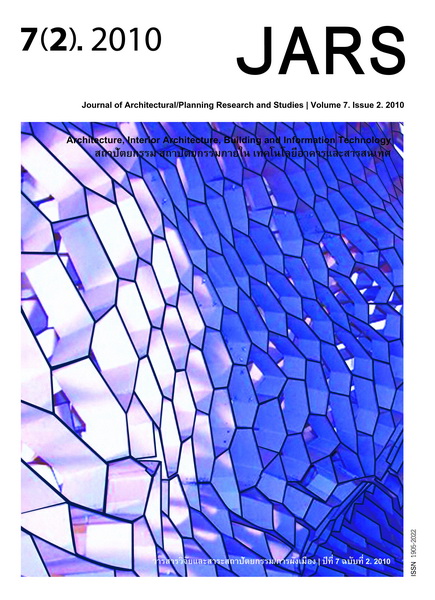Recalibrating the New Thai Vernacular Architecture
Main Article Content
Abstract
The emergence of the new types of vernacular houses shows the evidence of change leaping from
the popular image of the traditional Thai houses. The change is impacted from many factors including
contemporary cultural needs. New vernaculars, which are found in the central Thailand, are the transforming
Thai houses and the reproduction Thai houses. These two occurrences began since the 1960s (for
the first type) and the 1990s (for the second type). The vernacular houses were surveyed in Pak Kran
village and Bang Pahun area in Phra Nakhon Si Ayutthaya province during the 2000s. These new vernacular
houses have developed from the traditional Thai house among other modern housing developments.
However, there is lacking of awareness and understanding of the change. Most of the policies from Thai
government, study courses and research topics have focused only on the image in the past. Accordingly,
contemporary vernaculars tend to be disregarded. For recalibrating the new vernaculars in this paper, there
are three main subjects: 1. the viewpoints on vernacular architectures both from local and international
scholars; 2. the definitions and previous studies relating to vernaculars; and 3. the establishment of the new
vernacular architectures, which closely relate to the traditional Thai house. This paper involves developing
an understanding of vernaculars as well as providing ways to expand the scope of vernacular studies.
Downloads
Article Details

This work is licensed under a Creative Commons Attribution-NonCommercial-NoDerivatives 4.0 International License.
All material is licensed under the terms of the Creative Commons Attribution 4.0 International (CC-BY-NC-ND 4.0) License, unless otherwise stated. As such, authors are free to share, copy, and redistribute the material in any medium or format. The authors must give appropriate credit, provide a link to the license, and indicate if changes were made. The authors may do so in any reasonable manner, but not in any way that suggests the licensor endorses you or your use. The authors may not use the material for commercial purposes. If the authors remix, transform, or build upon the material, they may not distribute the modified material, unless permission is obtained from JARS. Final, accepted versions of the paper may be posted on third party repositories, provided appropriate acknowledgement to the original source is clearly noted.
References
AlSayyad, N. (2006). Foreword in vernacular architecture. In L. Asquith & Vellinga (Eds.), The twenty-first century: Theory, education and practice. Oxon: Taylor & Francis.
Brunskill, R. W. (2000). Vernacular architecture: An illustrated handbook. London: Faber and Faber Limited.
Correa, C. (1998). Foreword. In W. Lim & Beng (Eds.), The new architecture: Vernacular traditions and contemporary style. Tan Hock, Singapore: Tein Wah Press.
Denpaiboon, C. (2001). Transformation by modernization of the traditional waterfront settlements in the context of their coexistence with the aquatic environment. Kyoto: Graduate School of Engineering, Kyoto University.
Hengrasamee, D., Phalawattana, D., & Sutthitham, T. (1992). การพัฒนารูปแบบสถาปัตยกรรมบ้านพักอาศัยในชนบทอีสานแถบลุ่มแม่น้ำาชี [Development of architectural style of housing in rural area along the Chi River]. Khon Kaen, Thailand: Faculty of Architecture, Khon Kaen University.
Horayangkura, V. (2001). The architecture of thailand, change amid continuity: The new challenge in transforming traditions. Singapore: Asian Studies Publication Series.
Jaijongrak, R. (2000). Original Thai house. Pathumtani, Thailand: Thammasat Publishing.
Jotisalikorn, C. (2002). Classic Thai: Design-interior-architecture. Bangkok, Thailand: Asia Books.
Pengchad, L. (2002). A pattern of settlement at Doi Tung development project area: A case study of the akha tribe. Bangkok, Thailand: Silpakorn University.
Lim, W. (1998). The new architecture: Vernacular traditions and contemporary style. Singapore: Tein Wah Press.
Oliver, P. (1997). Encyclopaedia of vernacular architecture of the world. UK: Cambridge University Press.
Paribatra, S. (2002). ‘Forward’ in classic Thai: Design-interior-architecture. Bangkok, Thailand: Asia Books.
Pavlides, E. (1997). Architectural. In P. Oliver (Ed.), Encyclopedia of vernacular architecture of the world. UK: Cambridge University Press.
Pinijvarasin, W. (2004). Experiences of well-being in Thai vernacular houses. Melbourne, Australia: The University of Melbourne.
Puwanan, J. (2004). Steel industries and house construction in the future. Bangkok, Thailand: Chulalongkorn University Publishing.
Rapoport, A. (1969). House form and culture. Englewood Cliffs, N. J.: PrenticeHall.
Roonrakwit, P. (1997). Thailand and Southeast Asia. In P. Oliver (Ed.), Encyclopedia of vernacular architecture of the world. UK: Cambridge University Press.
Rudofsky, B. (1964). Architecture without architecture: A short introduction to non-pedigreed architecture. London: Academy Editions.
Silpakorn University. (1999). Master plan II for conservation and development of Ayutthaya the historical city (1997-1999). Bangkok, Thailand: Silpakorn University.
Thongsakul, N. (2001). A syntactic analysis of spatial configuration towards the understanding of continuity and change in vernacular living space: A case study in the upper. Florida: University of Florida.
Temiyabandha, W. (1994). The importance of vernacular architecture. ASA-Journal of Architecture, November, 43-52.
Temiyabandha, W. (1995). House in Northern Thailand. In Thai house. Bangkok, Thailand: Advance International Printing Service Bangkok.
Upton, D. (1993). The traditional of change. Traditional Dwellings and Settlements Review, 5(1), 9-15.
Vellinga, M. (2006). Engaging the future: Vernacular architecture studies. In L. Asquith & Vellinga (Eds.), The twenty-first century in vernacular architecture in the twenty-first century: Theory, education and practice. Oxon: Taylor & Francis.
Wongkham, C. (2001). Development of vernacular Kaloeng house: Case study of Ban Nong-Nounw, Mukdahan Province. Master Thesis, Faculty of Architecture, Silpakorn University, Bangkok, Thailand.


